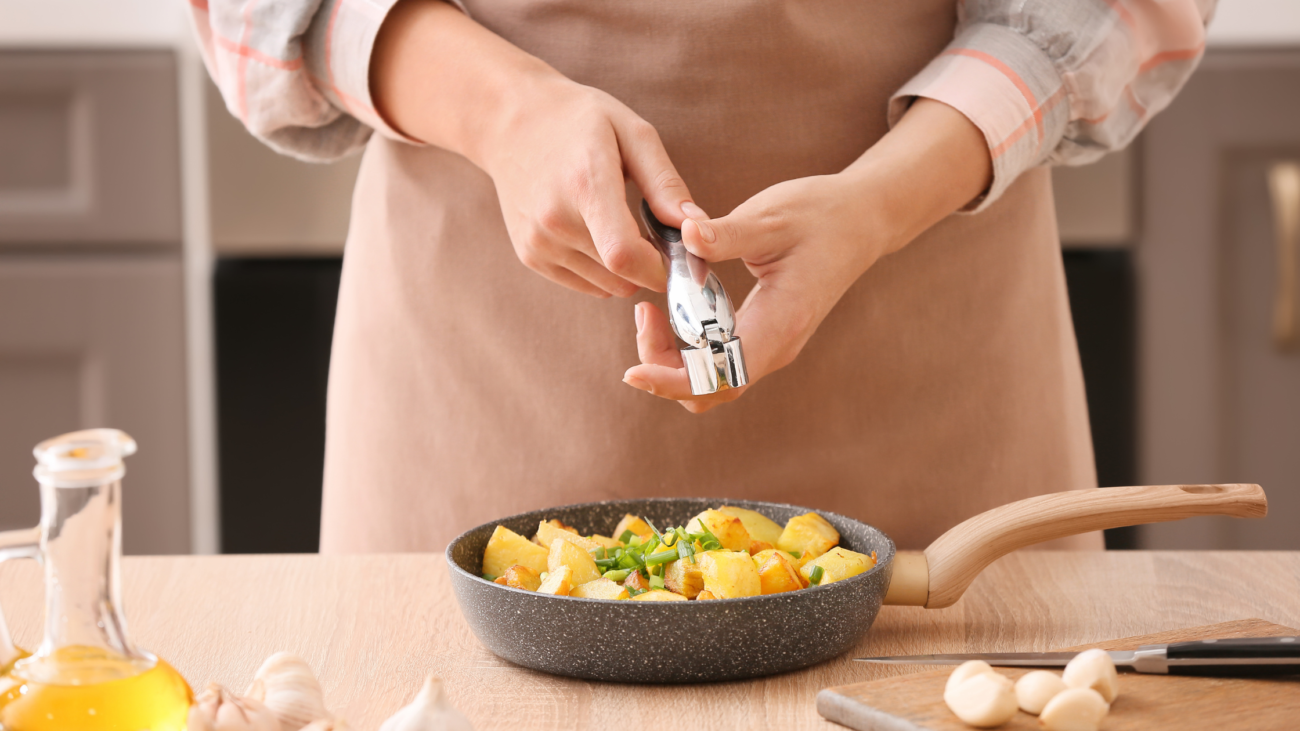Cooking at home can be a fulfilling and enjoyable activity, whether you’re preparing a quick weeknight dinner or hosting a weekend dinner party. However, to make your cooking experience easier, more efficient, and enjoyable, it’s important to have the right tools in your kitchen. While a professional kitchen may have an expansive array of specialized gadgets, as a home cook, it’s more practical to focus on the essentials—tools that serve multiple functions and can help you create a wide variety of dishes.
In this article, we will discuss the essential tools every home cook should have, highlighting items that will make cooking smoother, more efficient, and more enjoyable. From knives to cookware, we’ll cover everything you need to equip your kitchen for success.
1. Essential Knives
One of the most important investments a home cook can make is in a good set of knives. A sharp, high-quality knife is not only safer but also significantly improves the cooking experience. The most essential knives for every kitchen are:
Chef’s Knife
The chef’s knife is the cornerstone of any kitchen. It’s a versatile tool that can handle a wide variety of tasks, including chopping, slicing, dicing, and mincing. A good chef’s knife should feel comfortable in your hand and be well-balanced. It’s typically 8 inches in length, though you can opt for slightly shorter or longer versions depending on your preference.
Paring Knife
A paring knife is a smaller, more precise knife used for intricate tasks such as peeling, trimming, and slicing small fruits and vegetables. It’s essential for tasks that require accuracy, like deveining shrimp or removing seeds from peppers.
Serrated Knife
A serrated knife is perfect for cutting through items with a tough exterior and soft interior, such as bread or tomatoes. The teeth on the blade allow you to slice through delicate or crusty foods without crushing them.
Utility Knife
A utility knife is a medium-sized knife that fills the gap between a chef’s knife and a paring knife. It’s great for cutting items like sandwiches, larger fruits, or small cutting jobs that don’t require the precision of a paring knife.
2. Cutting Board
A sturdy cutting board is crucial for protecting your knives and countertops. While there are many options available, wooden or bamboo cutting boards are often preferred for their durability and knife-friendly surfaces. They also provide a stable platform for slicing and chopping.
For food safety, it’s a good idea to have separate cutting boards for raw meats and produce to prevent cross-contamination. Plastic cutting boards are easy to clean and sanitize but may develop knife scars over time. Wood, on the other hand, is gentler on knife blades.
3. Pots and Pans
A variety of pots and pans are essential for preparing different types of dishes. Every home cook should have the following cookware in their kitchen:
Non-Stick Frying Pan
A non-stick frying pan is ideal for cooking delicate foods like eggs, pancakes, or fish, as it prevents sticking and makes cleaning easier. Look for a non-stick pan with a sturdy handle that feels comfortable in your hand.
Cast Iron Skillet
A cast-iron skillet is a workhorse in the kitchen. It can be used for searing, frying, baking, and even roasting in the oven. Over time, cast iron improves with use, developing a natural non-stick surface. It’s also known for its excellent heat retention and even cooking.
Saucepan
A small to medium-sized saucepan is essential for cooking sauces, reheating soups, or boiling small amounts of food. It’s great for simmering and can be used for a variety of cooking techniques.
Stockpot
For soups, stews, pasta, or large batches of vegetables, a good stockpot is a must-have. It should have tall sides to allow for plenty of liquid to bubble up without spilling over. Ideally, the stockpot should have a lid and be made of a heavy, heat-conducting material.
4. Baking Sheets and Pans
If you enjoy baking, there are several baking tools that should be on hand:
Baking Sheet
A high-quality baking sheet is essential for roasting vegetables, baking cookies, or preparing sheet pan meals. A rimmed baking sheet provides stability and prevents ingredients from spilling over. Make sure to invest in a heavy-duty baking sheet that is resistant to warping under high heat.
Loaf Pan
A loaf pan is perfect for baking bread, meatloafs, or pound cakes. This versatile tool can be used for a variety of recipes and is a must-have for any home baker.
Round Cake Pans
If you love baking cakes, round cake pans are essential. You can use them to create layered cakes or prepare single-layer treats. Look for pans with a non-stick coating for easy release.
5. Mixing Bowls
Mixing bowls are a kitchen essential for both baking and cooking. You’ll need a set of various sizes to handle everything from small tasks (like whisking an egg) to larger tasks (like tossing a salad). Stainless steel, glass, and ceramic bowls are all good choices, and many sets include nesting bowls for easy storage.
6. Measuring Cups and Spoons
Accurate measurements are crucial in both cooking and baking. A good set of measuring cups and spoons ensures that you follow recipes properly. Make sure your set includes both dry and liquid measuring cups, as they are designed differently to accommodate their respective tasks.
Dry Measuring Cups
These are used for ingredients like flour, sugar, or spices. They usually come in a set of 1/4 cup, 1/3 cup, 1/2 cup, and 1 cup sizes.
Liquid Measuring Cups
These are typically made of glass or plastic and include a spout for easy pouring. They come in various sizes, including 1 cup, 2 cups, and 4 cups.
Measuring Spoons
Measuring spoons are essential for accurately measuring small quantities of ingredients such as salt, spices, and vanilla extract.
7. Tongs and Spatulas
Tongs and spatulas are both practical and versatile tools that are used in many cooking techniques.
Tongs
Tongs are perfect for flipping, stirring, and serving hot foods. They provide control and precision, especially when handling meat on the grill or pasta in boiling water.
Spatulas
A good spatula can be used for stirring, flipping, or scraping. Silicone spatulas are heat-resistant and gentle on non-stick cookware, while slotted spatulas are perfect for turning foods like burgers or eggs.
8. Colander
A colander is essential for draining pasta, washing vegetables, or rinsing canned beans. Stainless steel or plastic colanders are commonly used, but it’s important to choose one with sturdy handles and a wide base to prevent tipping when draining hot foods.
9. Can Opener
For opening cans of beans, tomatoes, or tuna, a reliable can opener is a must-have tool. Manual can openers are simple and easy to use, while electric versions make the process even faster. Make sure to choose a sturdy, ergonomic can opener that will last.
10. Food Processor
A food processor is a versatile tool that can chop, slice, shred, and puree ingredients. It’s especially helpful for meal prep, making dough, or quickly processing vegetables. While not strictly necessary for every cook, a food processor can save you time and effort when preparing meals.
11. FAQs about Essential Tools for Home Cooks
- Do I need all of these tools for basic cooking?
No, but having a few essential tools like a chef’s knife, cutting board, non-stick frying pan, and mixing bowls will go a long way in helping you prepare a variety of dishes. - What’s the best way to care for my kitchen tools?
Regular cleaning, proper storage, and maintenance are essential. For knives, keep them sharp and use a honing steel. For pans, avoid overheating and always wash them according to the manufacturer’s instructions. - Do I need expensive cookware for a great meal?
While high-quality cookware can improve your cooking experience, you don’t need to break the bank. Look for durable cookware that’s made from materials like stainless steel or cast iron. - Can I use a food processor for everything, or should I rely on manual tools?
A food processor is useful for many tasks, but it’s not necessary for every home cook. If you prefer manual techniques like hand-chopping or whisking, it’s completely fine to skip the food processor. - Is a cast iron skillet really worth the investment?
Yes, a cast iron skillet is incredibly versatile and long-lasting. It’s great for searing meat, frying, and even baking. Over time, it becomes more non-stick, which enhances its functionality. - How do I choose the right knives for my kitchen?
Look for knives that feel comfortable in your hand and suit your cooking style. A good chef’s knife, paring knife, and serrated knife should be enough for most tasks. - Do I need a non-stick pan if I’m using cast iron?
A non-stick pan is great for certain delicate foods, like eggs or pancakes, where you want to avoid sticking. Cast iron is best for high-heat cooking and searing, so having both options is ideal.
Conclusion
Having the right kitchen tools is essential for both novice and seasoned home cooks. By equipping your kitchen with essential tools such as quality knives, cookware, mixing bowls, and measuring utensils, you can streamline your cooking process, improve efficiency, and enhance the overall experience. Investing in durable and versatile items will not only make cooking more enjoyable but will also save you time and effort in the kitchen.
With these tools in hand, you can confidently tackle a wide range of recipes and cooking techniques, from simple weeknight dinners to more elaborate meals. A well-equipped kitchen is a place of creativity and efficiency, allowing you to cook with ease and confidence.
Key Takeaways:
- A good set of knives, a reliable cutting board, and versatile cookware are essential for every home cook.
- Essential kitchen tools, like a non-stick frying pan, chef’s knife, and measuring cups, can help streamline cooking and improve results.
- Investing in quality items, such as a cast iron skillet or food processor, will save time and effort in the long run.
- Regular maintenance and care for your kitchen tools will ensure their longevity and effectiveness.

